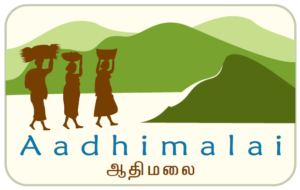In 2004-05 Keystone started setting up Area Resource Centres across the Nilgiri Biosphere Reserve. This was based in a central village, with many satellite hamlets being serviced by it.
Over time an important activity that these resource centres performed were related production and value addition of NTFPs and farm produce. Activities promoted through livelihood interventions of Keystone, yielded organic and sustainably harvested products. Instead of selling it in the open market, intervention was made to value add and sell it locally. One of the important aspects that was stressed upon was to have community membership in these centres. This enabled produce from many families to be aggregated and a select number of people, mainly women, were trained for value addition.
Over time, the centres’ role got diversified and they started acting primarily as a production centre. They also perform the role of:
- – A resource base for information and knowledge on forests, land, wildlife and water
- – A place to acquire more skills and appropriate technologies
- – A place for environment education and programmes for children
- – A centre for health education for women and children
- – A knowledge base on current laws and rights related to adivasis and forests
By 2013, all these units were federated and registered independently as a Producer Company. The production centres were registered under Aadhimalai Pazhangudiyinar Producer Company Limited.

The major active centres of Aadhimalai are:
Bangalapadigai
The production centre was started in 2003-04 and is located about 34 km distance on the eastern direction of Kotagiri, situated much lower elevation as 1000 msl. The Irula community practices excellent traditional millet farming in the region. The adjacent forest are a rich non timber forest bowl. Huge volumes of Shikkakai, Nelli, Soap berries, Phoenix leaves and Honey used to be collected in this region.
Among the agriculture produce, Silk cotton, coffee and pepper are the major products. It has developed as a centre for ginning and processing silk cotton today, among other things.
Hasanur
This centre was started during 2005- 06, traditionally called as “Mel seemai”, this falls in the Sathyamangalam Forest Division, with the largest forest area and the largest volume of NTFP collection in Tamil Nadu. It has been declared as a Tiger Reserve.
Predominantly, Irula community lives here with Sholigas, Uralis and Kurumbas. Traditional millet farming, cattle herding and NTFP collection for trading happens in a seasonal cycle. Thumbithakadu is the name of the centre, which means ”Prosperous” forest.
Thumbithakad is a combined initiative of three institutions namely Keystone Foundation, Minor Forest Collector’s Association and local NGO-TAMS (Thalavadi Adivasi Munetra Sangam). It is governed by the presidents of Village Forest Council (VFC) from Sathyamangalam forest division.
Women have quickly learned the value addition skill and are involved in selling it too. The centre has become a famous area for growing millet and value .
Pudukad
Parallel to the time of Thumbithakadu, a Kurumba girl, Susheela, took a lot of initiatives to start up this centre in the Coonoor slopes, and this centre was also started during 2005-06. There are two communities here of Kurumba’s and Irula’s. This is a pivotal centre for honey, balms, soaps and pickles.
Originally all value addition work began in a rented tribal residence and gradually got developed into a full fledged centre. The women in this centre despite having faced several challenges, have stood their ground and continued to do value addition and were recognized as a successful Tribal Women Enterprise in Nilgiris District, by the local government.
Pillur
This unit was initiated during 2007-08 and operates with minimum resources in the Pillur valley. Pillur is an ecologically sensitive area and NTFP resource rich region.
Despite the presence of a Hydel dam here, agriculture is rainfed for these tribal communities. The region is in the rain shadow area and has the presence of wild elephants, often leading to conict. Banana is a newly introduced crop in the region, which traditionally grows Millets, Pulses and Grains. Mettupalayam is the largest market and absorbs a large quantity of the harvest.
